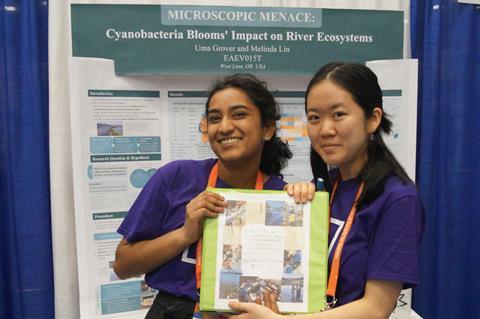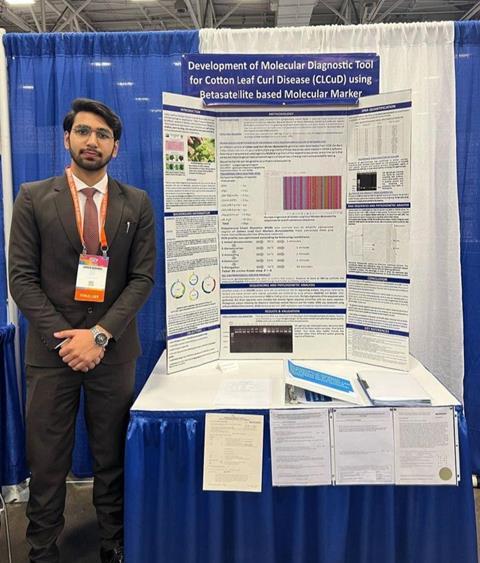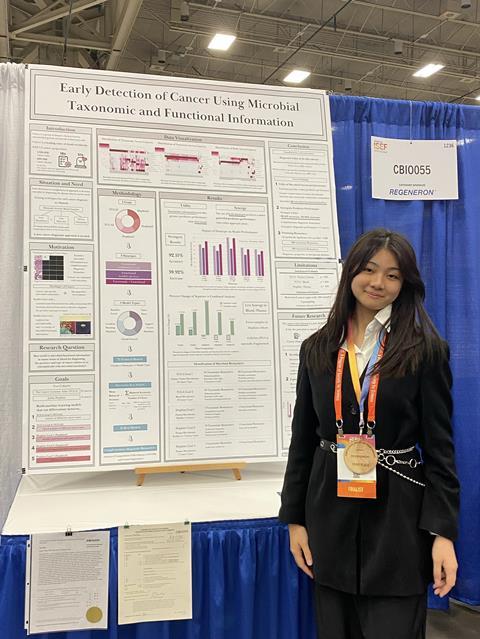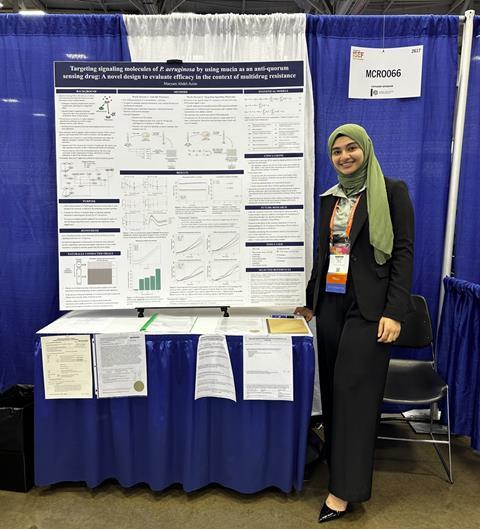To mark World Youth Skills Day on July 15, young people around the world have been invited to show off their skills, explain what makes them skilled, demonstrate their skill and celebrate their success.
We’re celebrating the upcoming generation of young microbiologists by highlighting some of the winners of the Grand Awards of Regeneron ISEF 2023, school students who earned the right to compete by winning a top prize at a local, regional, state or national science fair.
We talked to seven students who talked us through their award-winning projects and outlined what inspired them to undertake the work.
Uma Grover and Melinda Lin, West Linn High School, Portland, Oregon:
Microscopic Menace: What Are the Effects of Cyanobacteria Blooms on Primary Productivity, Toxicity, and Microorganisms?’
Our names are Uma and Melinda and we are from Portland, Oregon. We are 17 years old and are incoming freshmen at Cornell University. We’ve been studying a local harmful algal bloom (HAB) for the past two years by identifying HAB indicators and mechanisms for toxin release to help impacted communities prepare.

Every year, HABs harm waterways across the world. They occur when a bacteria called cyanobacteria multiply in large quantities, which has been happening more often due to higher temperatures as a result of climate change, as well as fertilizer pollution in rivers. Cyanobacteria release toxins known as microcystins which inhibit the biological pathways of many organisms, including humans. We studied a Willamette River HAB originating from the Ross Island Lagoon, the source of numerous Oregon Health Authority advisories due to high toxin levels.
During the summers of 2021 and 2022, we investigated the bloom by evaluating two sites - one affected site downstream from the bloom and one upstream control site. To assess the bloom’s environmental impact, we catalogued microorganisms’ measured primary productivity (how fast photosynthetic organisms metabolize), and analyzed toxicity using an ELISA kit.
We found the HABs were accompanied by lower productivity. Our data also suggested two mechanisms for toxin release: lower temperatures and cell death. As temperatures decreased, toxin levels in the water increased. Likewise, toxin levels went up as cyanobacteria died, which suggests that the toxins are internal to the bacteria cells. We also discovered a direct correlation between cyanobacteria and a square-shaped microorganism called melosira, so melosira could be bloom indicators.
The indicators our data support could allow us to predict these blooms ahead of time, which could help us protect our environment and local communities better. At the end of the day, this microscopic menace has a macroscopic impact.
Umer Sohail Meer (17), International School Lahore, Punjab, Pakistan:
Development of Molecular Diagnostic Tool for Cotton Leaf Curl Disease (CLCuD) Using Betasatellite Based Molecular Marker
I have developed a novel molecular diagnostic protocol for early detection of Cotton Leaf Curl Disease (CLCuD), a method which is practical, efficient, time-saving, economical, and easy to use.

Three million bales of cotton are lost each year due to CLCuD. This disease is caused by viruses that belong to the genus Begomovirus and is transmitted by different variants of whitefly vectors. My project describes the method and validation of the method whereby we can detect this disease in plants efficiently and with a single PCR, so that we can inform cotton breeders about the onset of disease, guide the selection and deployment of CLCuD-resistant genotypes and forecast changes in status of predominant viruses infecting cotton and abate leaf curl epidemics.
Previously detection was done on the basis of helper viruses which are distinct in each Begomovirus so we had to do multiple PCRs to confirm the presence of CLCuD in plants. I found out that there is something common in all strains of begomoviruses that cause CLCuD: betasatellite. Hence the detection on the basis of betasatellite proved more convenient and practical.
Moving onto methodology, I collected plant samples from symptomatic cotton fields in Pakistan, extracted DNA using CTAB method, then used the MEGAX software primer pair which targeted the conserved region of the sequence. The PCR was carried out to amplify the conserved region of the sequence followed by gel electrophoresis. Samples obtained were sent to a commercial lab in Korea for sequencing and sequences obtained were assembled, aligned and edited using BioEdit and DNASTAR software. Phylogenetic analysis reveals that all the sequences showed homology at 99-100 percent with CLCuMB sequences available in GenBank, so the study reports an efficient and reliable diagnostic test for early detection of CLCuD.
This disease is present in alternate hosts such as ornamentals and it evolves by recombination just like bacteria. It has a great potential to spread to uninfected growing regions of the world which include Australia, Brazil, and the US cotton-belt which will be devastating for cotton growers. For example, the Multan strain which originated in Pakistan has recently been found in China and the Philippines. Hence in order to stop the spread of the disease, application of this method in order to detect the disease prior to import or export will greatly reduce the likelihood of leaf curl virus introductions throughout the world which in turn will benefit cotton growers, farmers, textile industry, and agriculture industry worldwide.
Yue (Beth) Ding (17), Nikola Tesla STEM High School, Redmond, Washington, USA:
Early Detection of Cancer Using Microbial Taxonomic and Functional Information
Following my grandma’s cancer diagnosis, I ventured into cancer research and introduced a new cancer diagnostic approach using microbial taxonomy and functions after 7 months.

Early cancer detection is a novel approach to decrease mortality, but existing techniques using minimally invasive blood samples are limited. A novel strategy is to examine microbes, as researchers recently explained the diagnostic value of microbial taxonomy in tissue and blood.
Functional information remains unexplored - therefore, I examined the diagnostic utility of tumor and blood-derived microbial functional information and its potential synergy with microbial taxonomic information to explore the potential of a new microbial blood-based cancer diagnostic approach.
I trained 75 classification models (5 machine learning goals x 3 datatypes x 5 classification models) and determined the 15 best-performing models to analyze the utility and synergy of the microbial datatypes: taxonomy, functions, and both. Then, I performed differential abundance analysis to identify microbial biomarkers.
First, for the utility of microbial functions, I found that taxonomic information are stronger predictors than functional information, suggesting a greater conservation of tumor microbiome function.
Next, a synergistic predictive performance was achieved across 7+ cancer types! The highest percentage increase was ~40%, yielding an accuracy of over 92%. My new approach of examining both microbial taxonomy and functions brings us one step closer to diagnosing cancer with a simple blood test. Finally, I identified hundreds of biomarkers.
To me, the cancer microbiome (an integral aspect that only rose decades ago) is the future of cancer research. It holds tremendous potential for revolutionizing cancer diagnosis and treatment. Ultimately, microbes may have the answers to save millions of lives worldwide: perhaps your friends, your family, but most definitely, my grandma.
Rohak Jain, Interlake High School, Bellevue, Washington:
Deciphering a Sleeping Pathogen: Uncovering Novel Transcriptional Regulators of Hypoxia-Induced Dormancy in Mycobacterium Tuberculosis
My project uncovered a set of novel transcriptional mechanisms regulating hypoxia-induced dormancy in Mycobacterium tuberculosis, paving the way toward improved patient prognosis and more clinically-efficacious treatment options.

Each year, over 1.5 million lives each year are lost to tuberculosis infection and approximately two billion people, nearly a quarter of the global population, are infected with some form of latent TB. As TB spreads, the pathogen frequently finds itself in a state called hypoxia-induced dormancy, entering a non-replicating yet viable form that can reinitiate disease at unpredictable future time points and significantly strain the accuracy of diagnosis methods.
As such, my research sought to unearth novel transcriptional agents and regulatory mechanisms responsible for controlling the transition of MTB in and out of dormancy.
Classified as a lethal airborne disease, tuberculosis spreads when expelled droplets from the coughs or sneezes of an infected individual are inhaled, affecting millions of lives worldwide. However, when MTB reaches the oxygen-depleted, nutrient-starved environment of the lung granuloma, the bacterium, despite remaining viable, effectively shuts down its main metabolic activities and enters into a phase termed hypoxia-induced dormancy.
To hone in on key regulators of latency, I constructed an aggregate hypoxia dataset, inferred a gene regulatory network based on those observations, and leveraged functional enrichment and topological analyses to make sense of it all. Results indicated dormancy to be associated with cell redox homeostasis, metal ion cycling, and cell wall metabolism, revealing the essentiality of host-pathogen interactions. Additionally, crosstalk between select regulons (Rv0821c and Rv0144; Rv1152 and Rv2359) was shown to be critical in facilitating mycobacterial persistence and allowing MTB to gain control over key micronutrients within the cell.
In providing some of the first insights into the mechanisms utilized by MTB to endure in a hypoxic state, this study suggests a variety of predictive and rational strategies that might tremendously aid the clinical outcomes of TB treatment.
Maryam Abdel-Azim (17), Central Bucks High School East, PA, USA:
Targeting Signaling Molecules of P. aeruginosa by Using Mucin as an Anti-Quorum Sensing Drug: A Novel Design To Evaluate Efficacy in the Context of Multidrug Resistance
My name is Maryam Abdel-Azim and I am a 17-year-old at Central Bucks High School East in Doylestown, Pennsylvania. In my research project, I designed a framework to combat multidrug resistance in Pseudomonas aeruginosa by suppressing communication between bacteria using mucin, a chemical compound also naturally produced in the human body.

Pseudomonas aeruginosa is an opportunistic pathogen involved in several human diseases such as cystic fibrosis. This bacterium is highly resistant to antibiotic treatments due to its biofilm and pyocyanin production abilities which are regulated by quorum sensing (QS), the process of cell-to-cell communication between bacteria.
To activate QS, bacteria bind to signaling molecules released by their local population to gather information about bacterial cell abundance in the environment. Once a certain cell density has been reached, bacteria then turn into their disease-causing, virulent state.
Development of drugs that suppress QS will ‘blindfold’ rather than kill bacteria, thus preventing them from gaining resistance through genetic mutation. The most effective and precise way to suppress QS in the clinical setting is to specifically target the signaling molecules they release into the environment. To do this, I used mucin as an anti-quorum sensing drug which serves as a safe alternative to antibiotics, since variants of it are naturally produced by the immune system to combat infection.
This attempt of making smarter rather than more toxic medications is introduced as a paradigm shift from the era of antibiotics where bacteria quickly mutate to become multidrug resistant over time. I also introduce a generalizable laboratory pipeline and computational workflow to test and evaluate drug efficacy through time..
The results of this study demonstrated that mucin neutralizes QS signaling molecules and curbs the virulence of pathogenic bacteria, thus opening the door to the development of drugs with similar functions to be used in the clinical setting.
Amaya Etcheverry, Community School of Naples, FL, USA:
Concurrent Removal of Rising, Soluble Ocean Carbon Dioxide and Oil-in-Water Contaminants via Multi-Functional Remediation Framework
An open system bioreactor was created that uses a consortium of freshwater algae to generate sufficient voltage to power LED illumination systems while mitigating pollution from fossil fuel emissions. Although a ‘proof of concept’ model was produced and tested, the long-term goal would be to develop a scaled-up modular air pollution mitigation system that could be used to power street lamps while removing traffic pollution.

Air pollution from burning fossil fuels is associated with health issues such as respiratory and cardiac illnesses. In addition, fossil fuel combustion leads to pollution emissions that are equally detrimental to the environment. ‘Clean energy’ sources like solar panels can reduce fossil fuel consumption but also have significant downsides that make them less accessible and attractive to the population.
A consortium of algae, previously established to be reliable in improving overall air quality and decreasing common air pollutants, was used to create this system. To prove the concept viable, electrodes had to be established that could generate sufficient voltage, the resistance for maximum power output determined, and the electrically active system had to be tested to ensure that it maintained its remedial properties.
In addition, the longevity of the systems needed to be assessed for later application in the field. Initial tests determined the best electrodes for stable voltage to be a copper-cathode and magnesium-anode.
Although they were impacted by galvanized oxidation, the voltage was maintained for the duration of the experiment, and the electrically activated system maintained its ability to remediate air pollutants. A modular algae battery was produced that could power external illuminators while sequestering CO2 and purifying the air.
Topics
- Algae
- algal blooms
- Amaya Etcheverry
- Bacteria
- Be inspired
- Begomovirus
- bioreactor
- cancer microbiome
- Clinical & Diagnostics
- Cotton Leaf Curl Disease
- cyanobacteria
- Early Career Research
- Future Technologies
- Grand Awards of Regeneron ISEF 2023
- Maryam Abdel-Azim
- Melinda Lin
- Mycobacterium tuberculosis
- pollution
- Pseudomonas aeruginosa
- Rohak Jain
- Science Education & Outreach
- Uma Grover
- Umer Sohail Meer
- World Youth Skills Day 2023
- Yue Ding




No comments yet